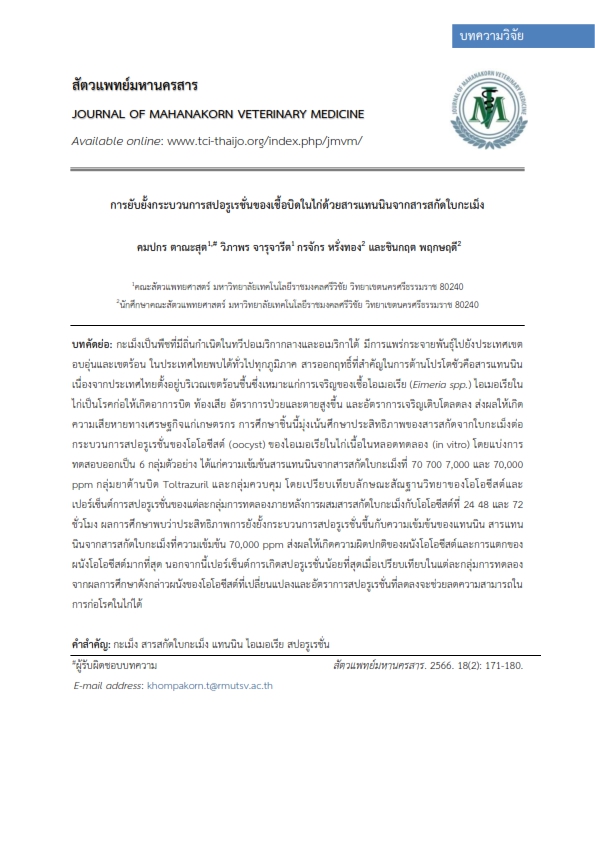Inhibition of Sporulation of Chicken Eimeria by Tannin from Kameng Leaf Extract
Main Article Content
Abstract
Kameng is a plant native to Central and South America. The species has spread to temperate and tropical countries. In Thailand, it can be found everywhere in every region. The main active ingredient against protozoa is tannin. Since Thailand is located in a tropical area suitable for the growth of Eimeria spp., this protozoa in chickens is a disease that causes dysentery, diarrhea and a higher morbidity and mortality rate and the growth rate was decreased. This results in economic damage to farmers. The aim of this study was to investigate the efficacy of a Kameng leaf extract on the sporulation rate of eimeria oocysts in broiler (in vitro). Experiment was separated into 6 groups. The tannin concentrations from Kameng leaf extract were at 70, 700, 7,000 and 70,000 ppm, the Toltrazuril anticoccidial group and the control group. The morphological characteristics of oocysts and sporulation rate of each experimental group were compared after mixing the leaf extract with oocysts at 24, 48 and 72 hours. The inhibition of the sporulation depends on the concentration of tannin. Tannin from Kameng leaf extract at a concentration of 70,000 ppm resulted in oocyst wall deformity and oocyst wall rupture the most. In addition, the sporulation rate was the lowest compared to each experimental group. According to the results of the study, the altered oocyst wall and reduced sporulation rate reduce the pathogenic capacity in chickens.
Article Details

This work is licensed under a Creative Commons Attribution-NonCommercial-NoDerivatives 4.0 International License.
References
SemSri, S., Kawon, T., Sukasem, J., Chanwittayanuchit, W., Nilsri, N. and Homwisetwongsa, S. 2017. Effects of kameng leaf extracts, sap suea leaves, centella asiatica and benggani cubs on blood clotting system. Huachiew Chalermprakiet Sci. Technol. J. 3(2): 42-53. (in Thai)
Allen, P.C. and Fetterer, R.H. 2002. Recent advances in biology and immunobiology of Eimeria species and in diagnosis and control of infection with these coccidian parasites of poultry. Clin. Microbiol. 15: 58–65.
Atawongsa, K. 2018 (cited 3 May 2022). Kameng: Valuable Weed. Available from: http://medherbguru.gpo.or.th/articles/D38_eclipta.pdf. (in Thai)
Aziza, A.E., Orma, O.A., Awadin, W.F. and Seady, Y.E.L. 2016. Effects of supplementation of broiler diets with fish oil and linseed oil on growth performance, cytokine, and cecal histopathological changes in broiler chicken infected by Eimeria tenella. Int. J. Agric. Sc. & Vet. Med. 4: 12–27.
Chung, K.T., Lu, Z. and Chou, M.W. 1998. Mechanism of inhibition of tannic acid and related compounds on the growth of intestinal bacteria. Food Chem. Toxicol. 36: 1053–1060.
Gopiesh, V. & Kannabiran, K. 2007. Larvicidal effect of Hemidesmus indicus, Gymnema sylvestre, and Eclipta prostrate against Culex qinquifaciatus mosquito larvae. Afr. J. Biotechnol. 6(3): 307-311.
Hafez, H.M. (2008). Poultry coccidiosis: Prevention and control approach. Eur. Poult. Sci. 72: 2–7.
Hamiza, O.O., Rehman, M.U., Tahir, M., Khan, R., Khan, A.Q., Lateef, A., Ali, F. and Sultana, S. 2012. Amelioration of 1,2Dimethylhydrazine (DMH) induced colon oxidative stress, inflammation and tumor promotion response by tannic acid in wistar rats. Asian Pacicfic J. Cancer Prev. 13: 4393–4402.
Jaisin, Y. (2016). Ka-meng. Thai J. Pharmacol. 38(2): 30-47.
Johnson, J. and Reid, W.M. 1970. Anticoccidial drugs: lesion scoring techniques in battery and floor-pen experiments with chickens. Exp. Parasitol. 28: 30–36.
Kalpana, P.R., Padma, R., Parvathy, N.G. and Renjith, V. 2013. Qualitative estimation of tannins, phenols and antioxidant activity of methanolic extract of Imperata cylindrica. Int. J. Res. Pharm. Sci. 4(1): 73-77.
Kaur, G., Athar, M. and Sarwar Alam, M. 2008. Quercus infectoria galls possess antioxidant activity and abrogates oxidative stress induced functional alterations in murine macrophages. Chem. Biol. Interact. 171: 272–282.
Kawahara, F., Zhang, G., Suzuki, T., Iwata, A. and Nagamune, K. 2014. Characterization of Eimeria brunetti isolated from a poultry farm in Japan. J. Vet. Med. Sci. 76: 25–29.
Kim, D.I., Lee, S.H., Choi, J.H., Lillehoj, H.S., Yu, M.H. and Lee, G.S. 2008. The butanol fraction of Eclipta prostrata (Linn) effectively reduces serum lipid levels and improves antioxidant activities in CD rats. Nutr. Res. 28(8): 550-554.
Min, B.R. and Hart, S.P. 2003. Tannins for suppression of internal parasites. J. Anim. Sci. 81(E. Suppl. 2), E102–E109.
Plumb, D.C. 2008. Plumb’s Veterinary Drug Handbook. 6th ed. Blackwell Publishing. Iowa. 1136 p.
Quiroz-Castañeda, R.E. and Dantán-González, E. 2015. Control of avian coccidiosis: future and present natural alternatives. BioMed Res. Int. 2015, http://dx.doi.org/10.1155/2015/430610.
Sasipreeyachan, J. 2010. Disease in Poultry. 1st ed. Thana Press. Bangkok. 338 p. (in Thai)
Scalbert, A. 1991. Antimicrobial properties of tannins. Phytochem. 30: 3875–3883.
Tewtrakul, S., Subhadhirasakul, S., Tansakul, P., Cheenpracha, S. and Karalai, C. 2011. Antiinflammatory constituents from Eclipta prostrata using RAW264.7 macrophage cells. Phytother. Res. 25(9): 1313-1316.
Tonda, R., Rubach, J., Lumpkins, B., Mathis, G. and Poss, M. 2018. Effects of tannic acid extract on performance and intestinal health of broiler chickens following coccidiosis vaccination and/or a mixed-species Eimeria challenge. Poult. Sci. 97: 3031–3042.
Tsuji, N., Kawazu, S., Ohta, M., Kamio, T., Isobe, T., Shimura, K. and Fujisaki, K. 1997. Discrimination of eight chicken Eimeria species using the two-step polymerase chain reaction. J. Parasitol. 83: 966–970.
Vrba, V., Poplstein, M. and Pakandl, M. 2011. The discovery of the two types of small subunit ribosomal RNA gene in Eimeria mitis contests the existence of E. mivati as independent species. Vet. Parasitol. 183: 47–53.


